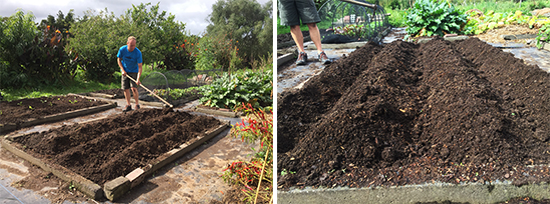
We might have been a bit premature in our last blog, saying the temperatures were cooling. But it’s fairly safe to say it now! We’re still waiting for the clear days with bright blue skies we usually get in March though, as rain still seems to be the order of the day. At least our hydro lakes are all full!
Green leafy vegetables
Right now we’re heading into a New Moon which is the best time to plant out the green leafy vegetables that will feed us over autumn and winter. Two weeks ago we prepared a bed by trenching it with compost and animal manures and adding garden lime to help break it all down. Now that bed is absolutely ready for planting.
Our plan is to plant chards – silverbeet, coloured chards and perpetual spinach (not a real spinach but a smaller, softer type of silverbeet which has less of a metallic taste and continues to grow after cutting, like a silverbeet).

Between our family and the chickens, we eat a lot of leafy greens over winter. Make sure you leave a good amount of space between your plants to allow for air movement to ward off rust. And if snails are a problem, now’s the time to set out some yeast traps.

How to plant leeks
We’re also going to get our leek seedlings in. They’re easy to grow and happy to sit in the garden until we’re ready to use them for winter soups and ragouts. The first thing to do is dig a trench. This is because the leeks will need to be hilled up as they grow. Hilling up allows leeks to produce nice, long, white tender stalks.

Separate the leek seedlings in some water to wash the soil off and bareroot them. With a pair of scissors, trim the tops off and if the roots are too long, they can be trimmed as well. Trimming gets them off to a better start.

Next, using a dibber or a stick, make a neat deep hole and pop the seedlings in about 10-15 cm apart, backfilling as you go. As they grow, keep filling in the trench. You may need to add more soil to achieve this. If your soil needs nutrients, a sprinkle of sheep pellets at this stage is a great addition for leeks.

Time to thin
The beetroot, turnips and daikon we sowed a few weeks ago need thinning. I always overplant seeds just in case the germination rate is poor. These seeds have germinated well however, so we need to thin them now before they get too big and we disturb their roots too much. Thinning gives the plants a better chance to grow strongly, as they’re not competing for nutrients or light. The seedlings we thin out can still be eaten in salads or given to my happy chooks.

The virtues of mesclun
The mesclun we planted during the last New Moon has grown huge with the warm, wet weather. We’ve had many meals from this small patch and it grows back so quickly. When you’ve had enough, you can dig it back into the soil as a green manure crop.

The insectary
One last reminder… as your summer flowers come to an end, replace them with winter-flowering varieties to feed our good bugs over the cooler months.

From Rob, Jan and the Team at OEG!
Website designed by www.thecornerstorecollective.com
Developed by Richard Hpa
7 Responses
Thank you Rob, I really enjoy reading your post.
I got breast cancer a few years ago and am trying to go organic! It’s a huge learning curve, especially in Taupo?
My chives has a tiny black bug ( size of the top of a pin) all over it.
I’ve cut it back to the ground but now the new shoots are coming back I can still see the black bug covering the new shoots
Hi Ann Sounds like you’re doing a great thing for your health 🙂 The little black bugs are onion aphids which love the allium family – chives, onions, garlic. leeks. We recommend you use neem oil. Mix it up as per the instructions and spray in the evening every third evening 3 times. When you’ve got rid of the population, cut the chives back to get rid of the damaged part of the plant and they’ll grow back healthily for you. All the best 🙂
Thank you so much, love your web site!
Do you have a blog or video on ways to erect netting over a garden so white butterfly and frost won’t do any damage ?
Sure. Here’s a video on how to make the hoops https://organicediblegarden.co.nz/2017/02/17-february-2017/
In this video https://organicediblegarden.co.nz/2016/07/15-july-2016/ we replace the netting with Mikroclima frost cloth which raises the soil temperature by 3-4 per cent in winter.
Hi,
I watched your programme on Choice TV and unfortunately didn’t save it.
Can you please give me the recipe for pickled carrots. I have a lovely crop about to be picked. 🙂
Sure. here’s the link and there’s a printer-friendly version too… https://organicediblegarden.co.nz/2017/05/cooking-with-carrots/ 🙂